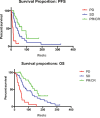Baseline clinical predictors of antitumor response to the PARP inhibitor olaparib in germline BRCA1/2 mutated patients with advanced ovarian cancer
- PMID: 28454085
- PMCID: PMC5564551
- DOI: 10.18632/oncotarget.17005
Baseline clinical predictors of antitumor response to the PARP inhibitor olaparib in germline BRCA1/2 mutated patients with advanced ovarian cancer
Abstract
Background: The PARP inhibitor olaparib was recently granted Food and Drug Administration (FDA) accelerated approval in patients with advanced BRCA1/2 mutation ovarian cancer. However, antitumor responses are observed in only approximately 40% of patients and the impact of baseline clinical factors on response to treatment remains unclear. Although platinum sensitivity has been suggested as a marker of response to PARP inhibitors, patients with platinum-resistant disease still respond to olaparib.
Results: 108 patients with advanced BRCA1/2 mutation ovarian cancers were included. The interval between the end of the most recent platinum chemotherapy and PARPi (PTPI) was used to predict response to olaparib independent of conventional definition of platinum sensitivity. RECIST complete response (CR) and partial response (PR) rates were 35% in patients with platinum-sensitive versus 13% in platinum-resistant (p<0.005). Independent of platinum sensitivity status, the RECIST CR/PR rates were 42% in patients with PTPI greater than 52 weeks and 18% in patients with PTPI less than 52 weeks (p=0.016). No association was found between baseline clinical factors such as FIGO staging, debulking surgery, BRCA1 versus BRCA2 mutations, prior history of breast cancer and prior chemotherapy for breast cancer, and the response to olaparib.
Methods: We conducted an international multicenter retrospective study to investigate the association between baseline clinical characteristics of patients with advanced BRCA1/2 mutation ovarian cancers from eight different cancer centers and their antitumor response to olaparib.
Conclusion: PTPI may be used to refine the prediction of response to PARP inhibition based on the conventional categorization of platinum sensitivity.
Keywords: BRCA; PARP inhibitor; olaparib; ovarian cancer; predictive biomarkers.
Conflict of interest statement
The authors declare no conflicts of interest.
Figures
References
-
- Audeh MW, Carmichael J, Penson RT, Friedlander M, Powell B, Bell-McGuinn KM, Scott C, Weitzel JN, Oaknin A, Loman N, Lu K, Schmutzler RK, Matulonis U, et al. Oral poly(ADP-ribose) polymerase inhibitor olaparib in patients with BRCA1 or BRCA2 mutations and recurrent ovarian cancer: a proof-of-concept trial. Lancet. 2010;376:245–51. doi: 10.1016/S0140-6736(10)60893-8. - DOI - PubMed
-
- Fong PC, Yap TA, Boss DS, Carden CP, Mergui-Roelvink M, Gourley C, De Greve J, Lubinski J, Shanley S, Messiou C, A'Hern R, Tutt A, Ashworth A, et al. Poly(ADP)-ribose polymerase inhibition: frequent durable responses in BRCA carrier ovarian cancer correlating with platinum-free interval. J Clin Oncol. 2010;28:2512–9. doi: 10.1200/JCO.2009.26.9589. - DOI - PubMed
-
- Gelmon KA, Tischkowitz M, Mackay H, Swenerton K, Robidoux A, Tonkin K, Hirte H, Huntsman D, Clemons M, Gilks B, Yerushalmi R, Macpherson E, Carmichael J, et al. Olaparib in patients with recurrent high-grade serous or poorly differentiated ovarian carcinoma or triple-negative breast cancer: a phase 2, multicentre, open-label, non-randomised study. Lancet Oncol. 2011;12:852–61. doi: 10.1016/S1470-2045(11)70214-5. - DOI - PubMed
MeSH terms
Substances
LinkOut - more resources
Full Text Sources
Other Literature Sources
Medical
Research Materials
Miscellaneous


